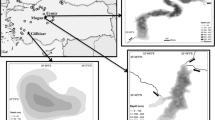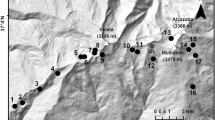Abstract
We examined the relationship between cladoceran, limnological, geological and biological variables in a recent sediment sequence to assess the cladoceran community response to flood conditions and human impacts during the last century in shallow Lake La Tembladera, on the southern coast of Ecuador. We recovered three sediment cores from central and littoral locations to analyze cladoceran subfossils and plant macrofossils. Redundancy analysis identified three environmental variables controlling the assemblage composition: the presence of non-aquatic plants, As and Be concentrations in the sediment. Before AD 1925, the surface area of the lake was smaller than it is now and the most representative cladocerans were Euryalona at lower lake levels and Leydigiopsis at relatively higher lake levels. After ca. AD 1925, anthropogenic works increased the lake level and the expanse of the littoral zone, favoring phytophilous cladocerans such as Kurzia. Around ca. AD 1990, the disposal of mining tailings contaminated with arsenic increased cladoceran sexual reproduction (total chydorid ephippia) and favored certain taxa. Our study shows the influence of anthropogenic activities on hydrologic regime, lake stage and heavy metal contamination and our results indicate the environmental trajectory of this lake, as it shifted from more natural to more impacted conditions in the last century.





Similar content being viewed by others
References
Alameida-Castillo MC, Santos-Wisniewski MJ (2013) First record of Oxyurella longicaudis (Birgei, 1910) (Cladocera: Chydoridae) in Minas Gerais, southeastern Brazil. Check List 9:647–648
APHA-AWWA-WEF (1992) Standard methods for the examination of water and wastewater. American Public Health Association, Washington
Aránguiz-Acuña A, Pérez-Portilla P (2017) Metal stress in zooplankton diapause production: post-hatching response. Ecotoxicology 26:329–339
Beijerinck W (1976) Zadenatlas der Nederlandsche flora. Backhuys & Meesters, Amsterdam
Bennion H, Simpson GL, Anderson NJ, Clarke G, Dong X, Hobaek A, Guilizzoni P, Marchetto A, Sayer CD, Thies H, Tolotti M (2011) Defining ecological and chemical reference conditions and restoration targets for nine European lakes. J Paleolimnol 45:415–431
Berglund BE, Ralska-Jasiewiczowa M (1986) Handbook of Holocene palaeoecology and palaeohydrology. Wiley, New York
Briones E, Gómez J, Hidalgo A, Tirira D, Flachier A (2001) Inventario de humedales del Ecuador. Segunda Parte. Humedales Interiores de la provincia de El Oro. Ecociencia, Quito
Brooks JL, Dodson SI (1965) Predation, body size, and composition of plankton. Science 150(3692):28–35
Colinvaux PA, Bush MB, Steinitz-Kannan M, Miller MC (1997) Glacial and postglacial pollen records from the Ecuadorian Andes and Amazon. Quat Res 48:69–78
Conroy JL, Overpeck JT, Cole JE, Shanahan TM, Steinitz-Kannan M (2008) Holocene changes in eastern tropical Pacific climate inferred from a Galápagos lake sediment record. Quat Sci Rev 27:1166–1180
Cowgill UM, Burns CW (1975) Differences in chemical compositions between two species of Daphnia and some freshwater algae cultured in the laboratory. Limnol Oceanogr 20:1005–1011
Elmoor-Loureiro LMA (2002) Occurrence of Kurzia polyspina Hudec (Crustacea, Anomopoda, Chydoridae) in Brazil. Rev Bras Zool 19(1):305–307
Fernando C, Tudorencea C, Mengestou S (1990) Invertebrate zooplankton predator composition and diversity in tropical lentic waters. Hydrobiologia 198:13–31
Frey DG (1982) Contrasting strategies of gamogenesis in northern and southern populations of Cladocera. Ecology 63:223–241
Grimm EC (1987) CONISS. A FORTRAN 77 program for stratigraphically constrained cluster analysis by the method of incremental sum of squares. Comput Geosci 13:13–35
Grimm EC (1990) TILIA 2.0. Software. Illinois State Museum, Springfield
Grimm EC (2004) Tilia Graph v. 2.0.2, Software. Illinois State Museum, Research and Collection Center, Springfield
Hannon GE, Gaillard MJ (1997) The plant-macrofossil record of past lake-level changes. J Paleolimnol 18:15–28
Hansen LJ, Whitehead JA, Anderson SL (2002) Solar UV radiation enhances the toxicity of arsenic in Ceriodaphnia dubia. Ecotoxicology 11:279–287
Harrison SP, Digerfeldt G (1993) European lakes as palaeo-hydrological and palaeoclimatic indicators. Quat Sci Rev 12:233–248
He X, Wang WS (2006) Releases of ingested phytoplankton carbon by Daphnia magna. Freshw Biol 51:649–665
Hutchinson M, Sarac Z, Norris A (2011) Mozambique tilapia: the potential for Mozambique tilapia Oreochromis mossambicus to invade the Murray–Daring Basin and the likely impacts: a review of existing information. Department of Employment, Economic Development and Innovation, Australian Government, Gladstone
Instituto Nacional de Preinversion (2003) Estudio de Impacto Ambiental Definitivo Embalse de la Represa de Tahuin. INASSA, Quito
Jeppesen E, Jensen JP, Sondergaard M, Lauridsen T, Landkildehus F (2000) Trophic strcuture, species richness and biodiversity in Danish lakes: changes along a phosphorus gradient. Freshw Biol 45:201–218
Kattel G (2012) Can we improve management practice of floodplain lakes using cladoceran zooplankton? River Res Appl 28:1113–1120
Kattel G, Dong X, Xiangdong Y (2016) A century-scale, human-induced ecohydrological evolution of wetlands of two large river basins in Australia (Murray) and China (Yangtze). Hydrol Earth Syst Sci 20:2151–2168
Kerrison PH, Annoni D, Zarini S, Ravera O, Moss B (1988) Effects of low concentrations of heavy metals on plankton community dynamics in a small, shallow, fertile lake. J Plankton Res 10:779–812
Kiser RV, Donaldson JR, Olson PR (1963) The effect of rotenone on zooplankton populations in freshwater lakes. Trans Am Fish Soc 92:17–24
Labaj AL, Michelutti N, Smol JP (2017) Changes in cladoceran assemblages from tropical high mountain lakes during periods of recent climate change. J Plankton Res 39:211–219
Ledrú MP, Jomelli V, Samaniego P, Vuille M, Hidalgo S, Herrera M, Ceron C (2013) The Medieval climate anomaly and the Little Ice Age in the eastern Ecuadorian Andes. Clim Past 9:307–321
Legendre P, Birks HJB (2012) From classical to canonical ordination. In: Birks HJB, Lotter AF, Juggins S, Smol JP (eds) Tracking environmental change using lake sediments. Volume 5: Data handling and numerical techniques. Springer, Dordrecht, pp 201–248
Li Y, Wang WX, Wang M (2017) Alleviation of mercury toxicity to a marine copepod under multigenerational exposure by ocean acidification. Sci Rep 7:324
Lim S, Ledrú MP, Valdez F, Devillers B, Houngnon A, Favier C, Bremond L (2014) Ecological effects of natural hazards and human activities on the Ecuadorian Pacific coast during the late Holocene. Palaeogeogr Palaeoclimatol Palaeoecol 415:197–209
López-Blanco C, Sinev AY (2016) Cladocera biodiversity in La Tembladera Lake (Ecuador). Crustaceana 89(14):1611–1637
López-Blanco C, Gaillard MJ, Miracle MR, Vicente E (2012a) Lake-level changes and fire history at Lagunillo del Tejo (Spain) during the last millennium: climate or humans? Holocene 22:551–560
López-Blanco C, Vicente E, Miracle MR (2012b) Cladocera sub-fossils and plant macrofossils as indicators of droughts in Lagunillo del Tejo (Spain)—implications for climatic studies. Fundam Appl Limnol 180:207–220
López-Blanco C, Kenney W, Varas A (2017) Recent flood management efforts obscure the climate signal in a sediment record from a tropical lake. J Palaeolimnol 58:467–478
Maeda S, Ohki A, Tokuda T, Ohmine M (1990) Transformation of arsenic compounds in a freshwater food chain. Appl Organomet Chem 4:251–254
Maeda S, Ohki A, Kusadome K, Kuroiwa T, Yoshifuku I, Naka K (1992) Bioaccumulation of arsenic and its fate in a freshwater food chain. Appl Organomet Chem 6:213–219
Michelutti N, Wolfe AP, Cooke CA, Hobbs WO, Vuille M, Smol JP (2015) Climate change forces new ecological states in tropical Andean lakes. PLoS ONE. https://doi.org/10.1371/journal.pone.0115338
Michelutti N, Lemmen JL, Cooke CA, Hobbs WO, Wolfe AP, Kurek J, Smol JP (2016a) Assessing the effects of climate and volcanism on diatoms and chironomid assemblages in an Andean lake near Quito, Ecuador. J Limnol 75:275–286
Michelutti N, Labaj AL, Grooms C, Smol JP (2016b) Equatorial mountain lakes show extended periods of thermal stratification with recent climate change. J Limnol 75:403–408
Milan M, Bindler R, Tolotti M (2016) Combining sediment Cladocera remains and geochemistry to reveal the role of a large catchment in driving changes in a small subalpine lake (Lake Ledro, N-Italy). Adv Oceanogr Limnol 7:220–234
Moy CM, Seltzer GO, Rodbell DT, Anderson DM (2002) Variability of El Niño/Southern Oscillation activity at millennial timescales during the Holocene epoch. Nature 420:162–165
Nevalainen L, Rantala MV, Luoto T (2015) Sedimentary cladoceran assemblages and their functional attributes record late Holocene climate variability in southern Finland. J Paleolimnol 54:239–252
Oksanen J, Blanchet FG, Friendly M, Kindt R, Legendre P, McGlinn D, Minchin PR, O’Hara RB, Simpson GL, Solymos P, Stevens MHH, Szoecs E, Wagner H (2015) Vegan: Community Ecology Package. R package version 2.4-0. http://CRAN.R-project.org/package=vegan
Perga ME, Frossard V, Jenny JP, Alric B, Arnaud F, Berthon V, Black JL, Domaizon I, Giguet-Covex C, Kirkham A, Magny M, Manca M, Marchetto A, Millet L, Paillès C, Pignot C, Poulenard J, Reys JL, Rimet F, Sabatier P, Savichycheva O, Sylvestre F, Verneaus V (2015) High-resolution paleolimnology opens new management perspectives for lakes adaptation to climate warming. Front Ecol Evol 3:72
Quevedo O (2010) Ficha informativa de los Humedales de Ramsar (FIR)-Version 2009-2012. Retrieved from: http://suia.ambiente.gob.ec/documents/783967/889253/Ficha+Ramsar+la+Tembladera.pdf/67e425db-7e16-455b-a5ef-34f8b8dc0dbb
Rodbell D, Seltzer GO, Anderson DM, Abbot MB, Enfield DB, Newman JH (1999) An approximately 15,000-year record of El Niño-driven alleviation in southwestern Ecuador. Science 283:516–520
Sales SSCM, Rietzler AC, Ribeiro MM (2016) Arsenic toxicity to cladocerans isolated and associated with iron: implications for aquatic environments. An Acad Bras Ciênc 88:539–548
Sarma SSS, Nandini S (2006) Review of recent ecotoxicological studies on cladocerans. J Environ Sci 41:1417–1430
Sarmaja-Korjonen K (2004) Chydorid ephippia as in dicators of environmental change—a new method. Hydrobiologia 526:129–136
Schnurrenberger D, Russell J, Kelts K (2003) Classification of lacustrine sediments based on sedimentary components. J Palaeolimnol 29:141–154
Schoch WH, Pawlik B, Schweingruber FH (1988) Botanische Makrorestes. Haupt, Bern
Seillès B, Sánchez Goñi MF, Ledru MP, Urrego DH, Martinez P, Hanquiez V, Schenider R (2015) Holocene land-sea climatic links on the equatorial Pacific coast (Bay of Guayaquil, Ecuador). Holocene 26:567–577
SGAB-Prodeminca (2000) Plan maestro ambiental para el distrito minero Portovelo-Zaruma y la cuenca del río Puyango. Prodeminca. Ministerio de Energía y Minas, Quito
Sinev AY, Elmoor-Loureiro LMA (2010) Three new species of chydorid cladocerans of subfamily Aloninae (Branchipoda: Anomopoda: Chydoridae) from Brazil. Zootaxa 2390:1–25
Smirnov N (2017) Physiology of the Cladocera, 2nd edn. Academic Press, Cambridge
Szeroczyńska K, Sarmaja-Korjonen K (2007) Atlas of subfossils Cladocera from Central and Northern Europe. Friends of the Lower Vistula Society, Swiecie (Poland)
Van-Damme K, Maiphae S (2013) Salinalona gen. nov., an euryhaline chydorid lineage (Crustacea: Branchiopoda: Cladocera: Anomopoda) from the Oriental region. J Limnol 72:142–173
Villalba R, Grosjean M, Kiefer T (2009) Long-term multi-proxy climate reconstructions and dynamics in South America (LOTRED-SA): state of the art and perspectives. Palaeogeogr Palaeoclimatol Palaeoecol 281:175–179
Acknowledgements
CLB acknowledges her grant to the Prometeo Project from the Secretaría de Educación Superior, Ciencia, Tecnología e Innovación de la República del Ecuador (SENESCYT). CLB thanks technicians from Santa Rosa government and population from San José, La Florida and San Agustín for their help during field work and information about the wetland. This work has been partially financed by the Project “Improvement of the conditions of small and artisanal mining in Ecuador” by the SENPLADES (Secretaría Nacional de Planificación y Desarrollo de Ecuador). CLB thanks the support of the Humboldt Foundation while submitting and revising this paper. We acknowledge the contributions of two anonymous reviewers who helped to improve the quality of this paper.
Author information
Authors and Affiliations
Corresponding author
Additional information
Handling Editor: Piet Spaak.
Rights and permissions
About this article
Cite this article
López-Blanco, C., Kenney, W.F. & Varas, A. Multiple stressors trigger ecological changes in tropical Lake La Tembladera (Ecuador). Aquat Ecol 52, 211–224 (2018). https://doi.org/10.1007/s10452-018-9656-5
Received:
Accepted:
Published:
Issue Date:
DOI: https://doi.org/10.1007/s10452-018-9656-5




